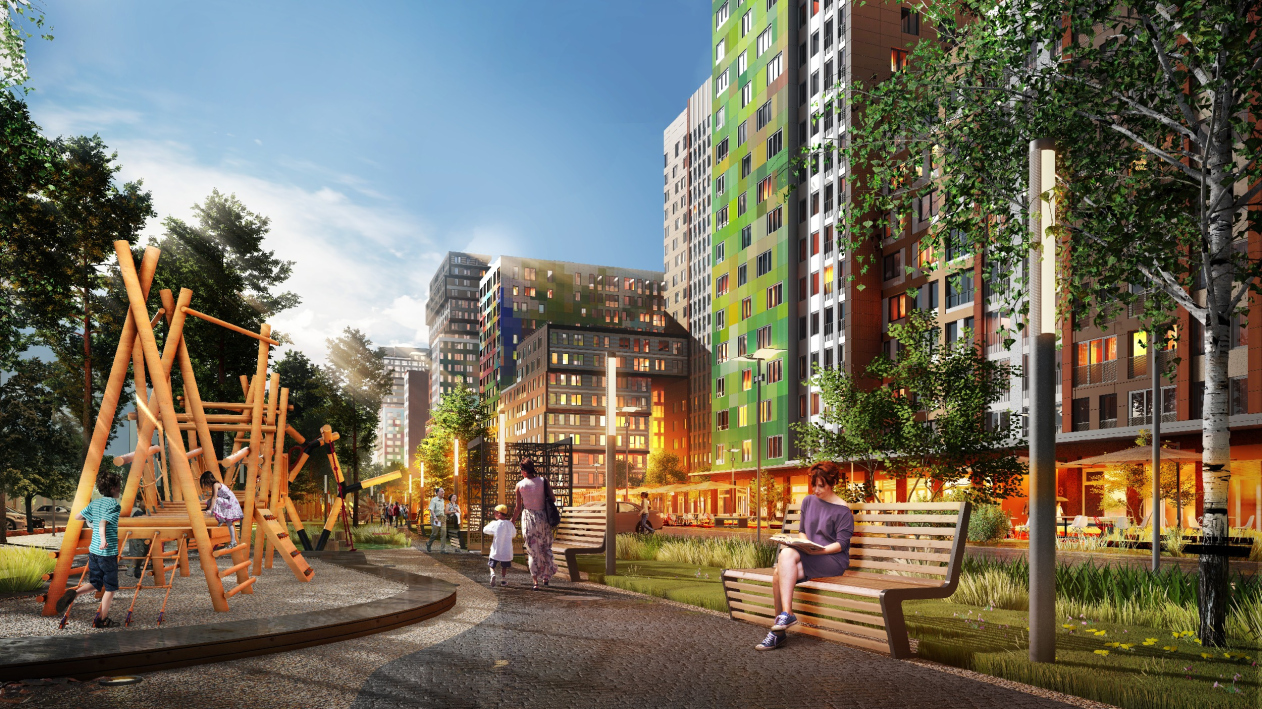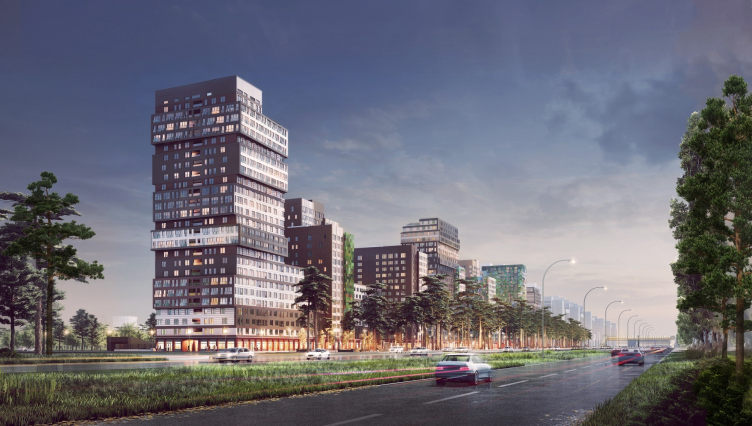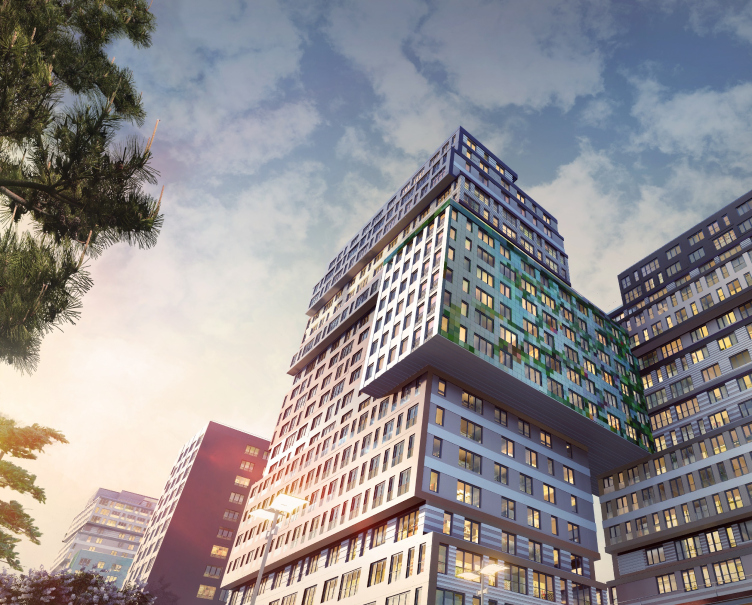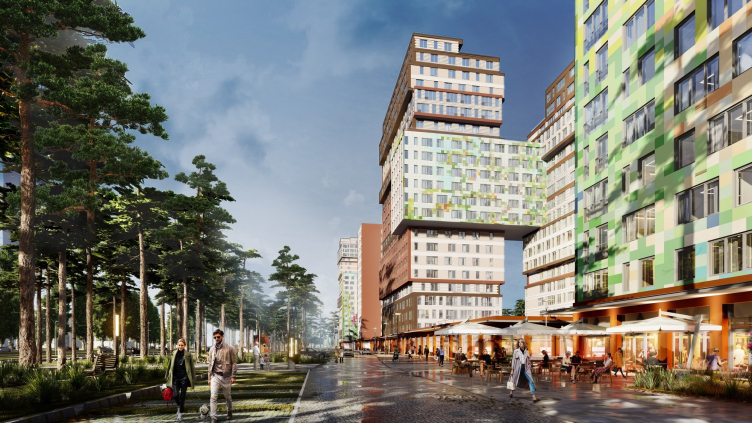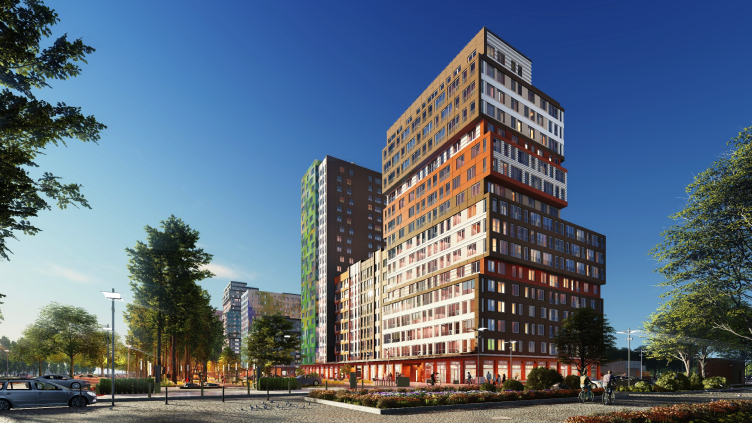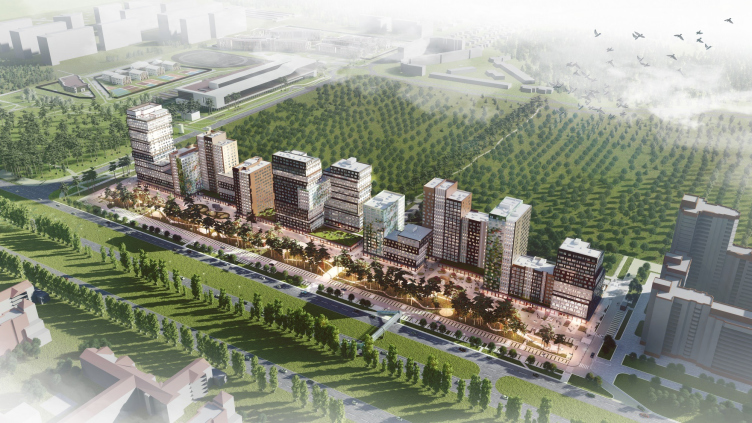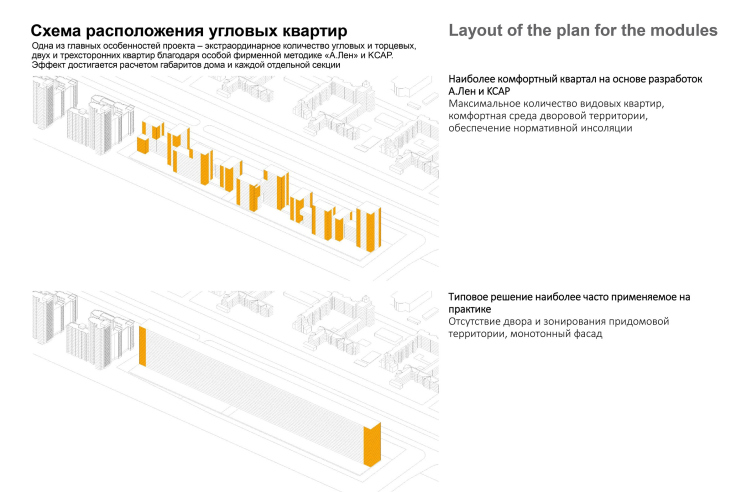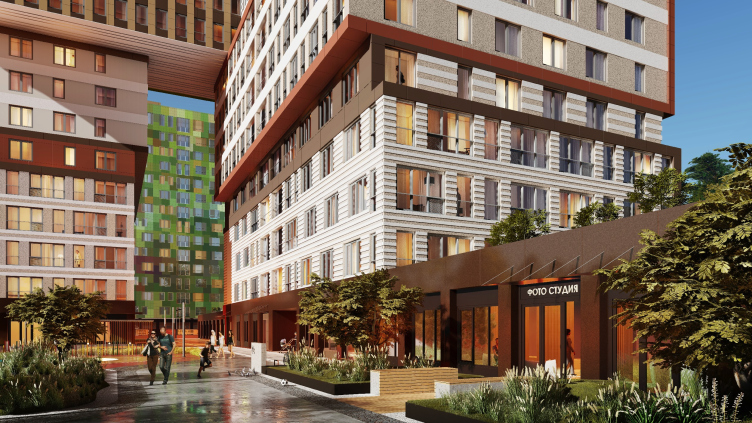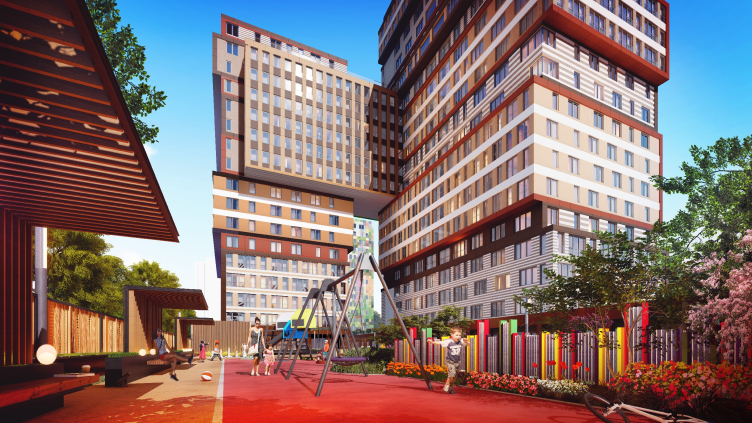A-Len does a lot of designing for the Russian regions, but Voronezh is a city where the company did more projects than anywhere else. Together with VDK, this Saint Petersburg-based architectural company has already built two housing complexes – “Pyat Stolits” (“Five Capitals”) and “Russky Avangard” (“Russian Avant-Garde”) – with another two complexes, “Bunin“ and “Grand Prix”, on the way. A few projects are also in the design stage; there are plans for developing the city’s social infrastructure, and inviting planners from overseas. The mastermind of the process is the developer Evgeny Khamin, whom Sergey Oreshkin characterizes as a “mover and shaker”, a visionary businessman who wants to make a difference to his home town.
It was also Evgeny Khamin’s idea to devote the future housing complex to Ivan Bunin, who was born here in Voronezh. The first planning idea was based on the simple rectangular shape of the land site situated at the entrance to the city from the Moscow side and surrounded by apple gardens, and literary associations of the “silver age” that the client named: stacks of books, rosewood table, and a green lamp – the architect shares. The first sketches by Sergey Oreshkin were approved, and later on many of his ideas were developed and can now be traced in the final project.
“Bunin” housing complex
Copyright: A-Len, KCAP Architects & Planners
A-Len, KCAP Architects & Planners
Copyright: A-Len, KCAP Architects & Planners
Then the client invited the Dutch company KCAP Architects&Planners. A-Len has already had an experience of collaborating with this firm, which is known in Russia, first of all, for designing the master plan of the city of Perm – and currently, A-Len, KCAP, and Orange are working together on a housing project named Golden City that is being built on the washed-up banks of the Vasilyevsky Island in Saint Petersburg.
The partner of KCAP Architects&Planners, Edward Schuurmans, is sharing: “When our colleagues from Saint Petersburg invited us again to work together on a new project – now in Voronezh – we agreed at once because the project task was unusual and interesting at the same time. It was unusual, first of all, because the sheer scale of construction turns the architectural task into a town planning one. Second, we could not help but accept the challenge of designing a landmark building at the entrance to the city. And, last but not least, we were thrilled at the prospect of using the name and the creative work of Ivan Bunin as the basis of the project’s marketing concept”.
After a joint brainstorming session, KCAP came up with about 15 models demonstrating volumetric solutions. Then the whole team, together with the client, gathered together in Rotterdam and chose the best one. When asked about how the roles were distributed, Sergey Oreshkin answered that it was “parallel work, very much like ping pong, a creative process that’s hard to define”, but nevertheless one must remember that KCAP are more of urban planners, while A-Len chiefly designs buildings.
“Bunin” housing complex. Birds-eye view
Copyright: A-Len, KCAP Architects & Planners
So! The form shaping is based on the theme of books: shelves, stacks, covers, and pages. Hence the combination of vertical and horizontal buildings, shifting of volumes, cantilevered structures, height differences from 26 to 9 floors, and a combination of “hard” and “soft” construction materials.
“Bunin” housing complex
Copyright: A-Len, KCAP Architects & Planners
The “stacks of books” on either side of the complex are essentially the “statement” towers, with yet another “stack” standing in the middle, where the road will run. Thanks to the use of different facade decorating materials, the vertical units are divided into several slim “volumes”. Their “pages” are indicated by light-colored stucco, while the “covers” are highlighted with natural stone, ceramic tiles, and metal.
“Bunin” housing complex. Facade 1
Copyright: A-Len, KCAP Architects & Planners
“Bunin” housing complex
Copyright: A-Len, KCAP Architects & Planners
In addition, there are also “wraparaounds” or “slipcovers” – colorful inserts with pixel fragments of Boris Kustodiev’s painting “The Apple Garden”. Yielding to the temptation of naively “painting” the facades was the easiest thing in the world, while finding a balance between such different colors and materials was no easy task – Sergey Oreshkin confesses. However, “Bunin” once again confirms A-Len’s interest for unconventional color design solutions – a similar design technique was applied in the housing complex “Russian Avant-Garde”.
“Bunin” housing complex
Copyright: A-Len, KCAP Architects & Planners
“Bunin” housing complex
Copyright: A-Len, KCAP Architects & Planners
Thanks to the ledges and shifts, examining the voids becomes just as exciting as examining the buildings themselves – thanks to their sheer scale, the step-like arches look pretty impressive, while the details add to the dramatic look of the complex: for example, KCAP draw huge street lights on their sketches, which bring associations with both a lampshade above the table on the veranda of a manor house, and associations with the arches of Saint Petersburg tenements with the first electric lights.
The diversity of volumes and colors is brought to one common denominator by the plinth that, according to the original concept, is meant to embody a “writing desk”. The land site is rather narrow – the buildings occupy almost the whole of its width, standing in a string, yet the complex somehow escapes from looking like a “blind wall”.
“Bunin” housing complex
Copyright: A-Len, KCAP Architects & Planners
Due to its sophisticated shape, the complex also got unconventional housing sections and a wide range of different apartment layouts. For about 10 years, A-Len has been working on its “Perfect Apartments” program: the company’s experts have been studying the best Russian, European, and especially – according to Sergey Oreshkin – Soviet apartment layouts, choosing the best ones and improving them with consideration of the realities of today’s housing market. Ultimately, the experts are getting a voluminous catalogue of efficient and ergonomic layouts – there are about 1300 options to choose from, their list including experimental ones, such as the Marseille Unit, or multilevel apartments that back in the day were developed by the Construction Committee of the Russian Federation under the supervision of Moisey Ginzburg. The validity of this method is backed up by the fact that usually the developer’s marketing departments approve the plans within a couple of days – the architect shares. The “Perfect Apartments” program is patented.
The housing complex “Bunin” contains 1438 apartments, their range including an unusually high number of corner and side-end ones, two and even triple-sided. There are also “office apartments” designed especially for those who dreams of coming to work “with their slippers on”.
“Bunin” housing complex
Copyright: A-Len, KCAP Architects & Planners
“Bunin” housing complex
Copyright: A-Len, KCAP Architects & Planners
The “Bunin” image is also fostered by the accompanying landscaping project, which, thanks to the specifics of the land site, also turned out to be very interesting. From the side of the Moskovsky Avenue, a city park will appear that will back up the commercial areas on the first floors. As for the overall spirit of this space that they are ultimately getting, the architects describe it as “Levitan” (another famous Russian landscape painter): the already existing pine grove will be adorned with sculptures and installations that will not, however, disrupt its natural feel. Behind the complex, there will be a garden with playgrounds and sports fields, brighter, more energetic, and less meditative. According to Sergey Oreshkin, the landscaping culture in Voronezh is “head and shoulders above Saint Petersburg not only because of the city’s climate but because of the quality of execution”. Therefore, the architects ventured to enhance “the fifth facade”: the roofs that can be seen from the windows of the neighboring buildings will be turned into operated green ones.
Edward Schuurmans emphasizes: “We believe that if you want your project, situated at the entrance to the city, to become a true landmark, you need to design it as a single-cut ensemble, creating, at the same time, a human friendly environment on the street level. This was a very challenging period of working with a few different scales at once – designing the silhouette of the entire complex and all of the facades at the same time. Our special focus was on the facades of the bottom floors. It is these facades that define the quality of the pedestrian environment all along the commercial front, which also includes the residential hallway entrances. And, of course, an import part of our work was creating an interface between the buildings and the open space: how the commercial function meets the new park from the side of the Moskovsky Avenue, and how the yard on the other side of the ensemble meets the apple gardens”.
Among other things, in the future, “Bunin” may become a part of a circular eco route: the city is planning to introduce a single path that will unite a large number of green areas – a tree nursery, botanical gardens, the central park, natural and archaeological sites on the Voronezh River.
***
It must be said that Ivan Bunin, books, and the green lamp are themes that are very challenging architecture-wise – not to say dowright dangerous. Working with such powerful, tell-tale, and, let’s admit it, proverbial prototypes, one is inevitably running a risk of ending up with excessive imagery that will make one’s project overly “literary”. However, looking at this specific project one can see that, yes, book are there, and they are quite recognizable from the axonometric drawings of the complex, but the point is that the international team was indeed able to achieve the necessary level of generalization when working with the form and meanings. The volumes resting on the plinth resemble books in a less obvious way than what we can see in the modernist experiments of the seventies, sometimes getting into resonance with the patterns of large volumes, characteristic for the Dutch architecture of the XXI century, with the language of cyclopean protrusions and cavities that oftentimes reminds us about the Cretan and Mycenaean sources of the European culture. This is how the circumstances fell into place, and the theme successfully coincided with the architects’ outlook on the possibilities of making a large form come alive, and the pixel shades – maybe the reflections of the Voronezh pine forests or the reminder of “The Dark Alleys” – turned out to be quite appropriate, recognizable to a decent extent, yet not memetic.
“Bunin” housing complex
Copyright: A-Len, KCAP Architects & Planners
In addition, what is also important is the fact that the “literary” house, whose name and imagery interpret the history of the city, can be considered an input to creating the “brand” of Voronezh, based on its own history – and this is not your Château de Val on the Central Russian Upland – this is our native Russian writer, even if he is buried at Sainte-Geneviève-des-Bois. This house, named after Ivan Bunin, a writer bearing the image of a “Russian barin”, who was born here but died in France, is being designed in Voronezh by Russian and Dutch architects – yet, unlike the writer’s fate, the collision is not in the least dramatic because it belongs to this modern age of total reconciliation and is based upon the search for the specifics in generalities: the literary history becomes the starting point for new modern forms to appear.

